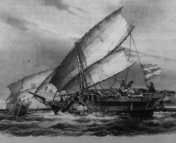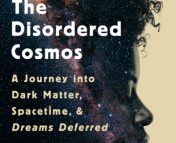November is National Native American Heritage Month in the United States, which itself is a country comprised of ancestral and unceded territories of countless Indigenous nations. In this Bite, we highlight the expansive astronomical knowledge held by First Nations across the globe, with a review of a fantastic book published earlier this year: The First Astronomers: How Indigenous Elders read the stars by Duane Hamacher with Elders and Knowledge Holders.
“Our traditions around the stars go back to ancient times. It’s connected to everything in our entire being and who we are in the world. For Indigenous people, it’s not just the land and the sea. It’s also the sky and in using those reference points. It assigns not just who we are, but our responsibilities as well.” —Professor Martin Nakata, in The First Astronomers
Often in astronomy, Indigenous Knowledge is framed in opposition to Western science. Take, for example, the situation on Mauna Kea, where Native Hawaiians have opposed the construction of the Thirty Meter Telescope on the sacred mountain. Some have viewed this as a battle between opposite forces of Indigenous cultures and the progress of science, when it is no such thing. Such a framing disrespects the richness of Indigenous scientific knowledge, and the deep connections that many First Peoples have to the land and the sky.
The First Astronomers: How Indigenous Elders read the stars by astronomer Duane Hamacher begins to repair this broken bridge between Western science and Indigenous Knowledge, lifting up the incredible detail of Indigenous observations and the vibrant stories used to pass down this knowledge between generations.
“The First Astronomers challenges commonly held views that Indigenous ways of knowing do not contain science,” says Hamacher in the preface. “It showcases the deep layers of star knowledge that are based on observation, deduction, experimentation, and collective wisdom that provides insights and solutions to some of the problems we face today.”
Indigenous Astronomy is Based in Observations
Indigenous Knowledge is different from and complimentary to Western science, although both are based on rigorous observation. One striking difference is the inclusion of “dark constellations” in Indigenous astronomy, such as the light and dark areas of the Milky Way, known to the Mayans as Saki bé (“white road”) and Xibalbá be (“path to the Underworld”). Some Aboriginal Australians see the dark constellation of the emu in the dark spaces of the Milky Way between the Southern Cross and Sagittarius — although there are many names for this constellation, since there are over 250 Aboriginal languages in Australia.
“Of course, each culture has its own constellations, and many of them do not follow the same ‘rules’ set out by Western science,” says Hamacher on pg. 120. “Indigenous constellations can overlap with one another, and they can have different meanings and names throughout the year, depending on their movements and orientations.”
To illustrate the precision of First Peoples’ observations, Hamacher tells of Venus, which sometimes appears in the morning and sometimes in the evening, depending on its orbital position relative to Earth. On pg. 97, Hamacher explains: “Through observations, First Peoples had worked out that the northerly standstill of Venus as an Evening Star coincides with the start of the rainy season…it demonstrates that Venus obeys a complex set of rules and requires very careful, long-term observations to understand them. And that’s exactly what First Peoples did.”
Indigenous Astronomy Has Many Uses for the Stars
The chapters of The First Astronomers cover the Sun, the Moon, planets, stars, variable stars, and other celestial objects, and how each of them was used for navigation, telling time, regulating planting and harvesting, and more. Hamacher recounted a particularly fascinating practice known as Songlines, travel routes on the ground that were mapped out in star positions on the sky. “These Songlines and travel routes have been in use for long periods of time as people crisscrossed the country. When the first waves of colonists spread across the land, they used many of these existing pathways…” says Hamacher. “Over time, the waypoints on the land became camps, then colonial settlements, and eventually towns and cities. The pathways between them became roads and highways. What you can see today is that many of the towns and road networks in Queensland, as elsewhere, are reflections of the Aboriginal star maps.”
Hamacher also describes many of the ways the sky was used for time-keeping and creating calendars, from nations in Australia who tracked the most plentiful fish populations to nations in the Americas who created monuments such as those in Chaco Canyon to mark the calendar. The famous Aztec and Mayan calendars also get a mention, of course, but a more fascinating bit is that these calendars also show how the Aztecs and Mayans observed sunspots. “Pictograms of the Mayan Sun-deity show him with and without spots on his cheeks,” explains Hamacher. With accurate dating, research has shown that the pictograms with spots correspond to years of high solar activity based on the solar cycle, and those with no spots correspond to low solar activity.
Indigenous Astronomy is Happening Today
Although Indigenous peoples and their knowledge and cultures are too often spoken of as a historical phenomenon, they are, in fact, alive and still practicing their traditions and astronomical observations today. Hamacher’s book is the product of collaboration with living Indigenous Elders, and he names many of them as co-creators, with permission of course: Ghillar Michael Anderson, John Barsa, David Bosun, Ron Day, Segar Passi, and Alo Tapim.
There are also Indigenous astronomers with doctoral degrees in Western Astronomy, although they are drastically underrepresented. According to The First Astronomers, there is only one Aboriginal Australian astrophysicist with a PhD. Recently, Dr. Pauline Harris was the first Maōri person to earn a PhD in physics, and Dr. Motheo Koitsiwe was the first African to earn a PhD in Indigenous Astronomy. There are also a number of First Nations scholars and Elders in North America — Wilfred Buck, Arvol Looking Horse, Dr. Nancy Maryboy, and David Begay to name a few — and some, like Dr. Annette Lee who created Native Skywatchers, focus on integrating Indigenous Knowledge into astronomy education.
Indigenous Astronomy is Crucial to the Future of Science
One of the core arguments of this book is that Indigenous Knowledge can add to the Western ways of knowing, just as having multiple perspectives can always be useful when tackling a difficult problem in science. This collaboration can even help avoid incorrect work — for example, in interpretations of astronomical petroglyphs. He mentions one specific case: there are ancient Chinese documents of the 1054 AD “guest star” corresponding to the supernova progenitor of the Crab Nebula, and many have tried to argue that the Chaco Canyon petroglyphs are also showing SN 1054, but we don’t really have evidence that is true. Hamacher explains, “The reality is that without knowledge from the Traditional Custodians, it is difficult to know, and making unsubstantiated claims is simply poor scholarship.”
There are also important roles for Indigenous Knowledge in the context of astronomy, not just history and archaeology. As Hamacher says on pgs. 192-193, “The teachings of Elders, as well as new perspectives on old historical records, show that Indigenous Knowledge is constantly changing ideas and challenging claims in the history and philosophy of science. This knowledge is also informing practices in modern astrophysics. Indigenous descriptions of new stars appearing in the sky can guide astronomers as to where they should point their telescopes…Alternatively, astronomers searching for the faint shells of dead stars might discover the remnant of a supernova that was visible as a bright star in the sky a few thousand years ago, which may be recorded in oral tradition…Astrophysicists and Elders working together to learn more about our Universe is an exciting prospect.”
The First Astronomers opens the eyes of its readers to other ways of knowing, and highlights the knowledge and culture of First Nations from around the world. Whether you’re a professional astronomer, a history buff, or someone who thinks the night sky is just cool, this book will broaden your horizons on how humans have observed the sky throughout our past and present.
Astrobite edited by: Katya Gozman
Featured image credit: Duane Hamacher, Allen & Unwin
This work was completed on Gabrielino/Tongva land, once known as Tovaangar until its colonization. Many indigenous people still live in this region today.




